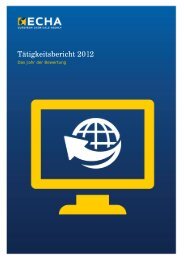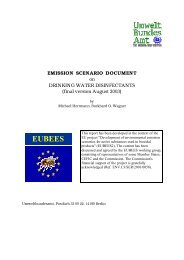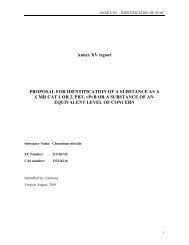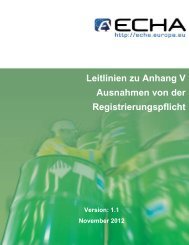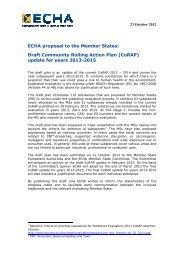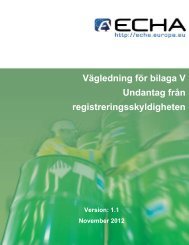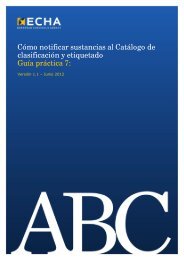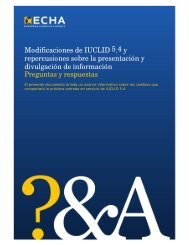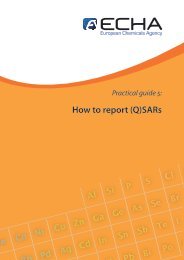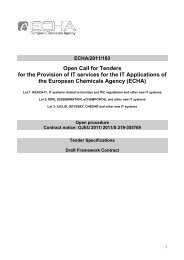Strategy For Limiting Risks Human Health Draft of ... - ECHA - Europa
Strategy For Limiting Risks Human Health Draft of ... - ECHA - Europa
Strategy For Limiting Risks Human Health Draft of ... - ECHA - Europa
You also want an ePaper? Increase the reach of your titles
YUMPU automatically turns print PDFs into web optimized ePapers that Google loves.
outes, as well as possible differences in bioavailability between animals and humans are<br />
accounted for in the calculation <strong>of</strong> the corrected NOAEL. If necessary in occupational risk<br />
assessment, the starting point for inhalation risk assessment also includes a correction for the<br />
difference between the standard respiratory volume <strong>of</strong> a person at rest (6.7 m³) and the<br />
respiratory volume <strong>of</strong> workers under light activity (10 m³).<br />
MOS values are calculated for different routes <strong>of</strong> exposure and for different toxicological<br />
endpoints. In occupational risk assessment inhalation and dermal contact generally resemble<br />
the relevant exposure routes. In addition, for assessment <strong>of</strong> combined risks the simultaneous<br />
exposure by inhalation and dermal contact needs to be considered. <strong>For</strong> cryolite the adequate<br />
NOAEL in this case is given by the respective internal level <strong>of</strong> fluoride which is expressed as<br />
well in mg F⎯/person as in mg F⎯/kg. This is easily comparable to the data on occupational<br />
and non-occupational fluoride uptake, which also are given as internal values (internal body<br />
burden). Inhalation exposure and dermal exposure to cryolite may contribute differently to the<br />
internal body burden <strong>of</strong> fluoride. With respect to the possible outcome <strong>of</strong> an assessment for<br />
combined risks, interest focuses on scenarios with conclusion ii at both exposure routes.<br />
Based on theoretical considerations, combined exposure will not increase the most critical<br />
route-specific risk component more than twice.<br />
Reference MOS<br />
The MOS values calculated have to be compared with a reference MOS. The reference MOS<br />
results an overall assessment factor from the multiplication <strong>of</strong> the different specific factors for<br />
a certain risk situation. The Technical Guidance Document emphasis the different aspects<br />
which are involved in these considerations, especially the extrapolation <strong>of</strong> experimental data<br />
to the human situation. <strong>For</strong> several aspects default assessment factors are recommended. It is<br />
important to point out that any relevant substance-specific data and information may overrule<br />
the defined default values.<br />
Interspecies extrapolation as one central element is based on allometric scaling (factor 4 for<br />
rats, factor 7 for mice, and factor 2 for rabbits). <strong>For</strong> remaining interspecies differences the<br />
TGD proposes an additional factor <strong>of</strong> 2.5. Another element is adjustment for intraspecies<br />
differences. <strong>For</strong> workers, a default factor <strong>of</strong> 5 is recommended, based on an evaluation <strong>of</strong><br />
empirical data by Schneider et al. (2004). It is anticipated that a default factor <strong>of</strong> 5 will be<br />
sufficient to protect the major part <strong>of</strong> the worker population (about 95%). <strong>For</strong> cryolite these<br />
default assessment factors are indicated for some endpoints only, because in most cases<br />
reliable human data are available which are preferred as direct basis for the assessment.<br />
It is usually expected that the experimental NOAEL will decrease with increasing duration <strong>of</strong><br />
application. Furthermore, other and more serious adverse effects may appear with prolonged<br />
exposure duration. This may result in the necessity to perform a duration adjustment <strong>of</strong> data<br />
using default factors. <strong>For</strong> cryolite however, data on health effects after chronic exposure are<br />
available which are sufficient for the assessment. There is no need for a numerical correction.<br />
The TGD describes two further adjustment factors (uncertainty in route-to-route extrapolation<br />
and dose-response relationship including severity <strong>of</strong> effect) which in specific cases may be<br />
different from one. <strong>For</strong> cryolite there are uncertainties from route-to-route extrapolation and<br />
from dose-response relationship especially for the endpoint carcinogenicity. However, the<br />
problem is not dealt with additional assessment factors but reference is made to repeated dose<br />
toxicity and the respective risk characterisation.<br />
14



